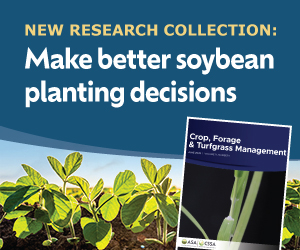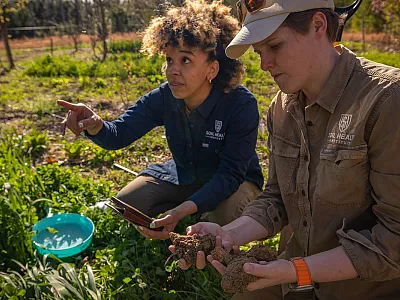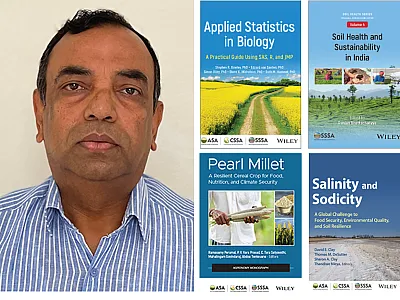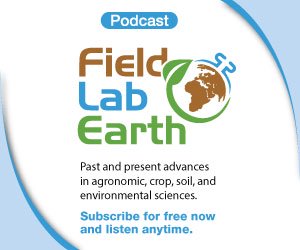Moving Bermudagrass into Temperate Regions
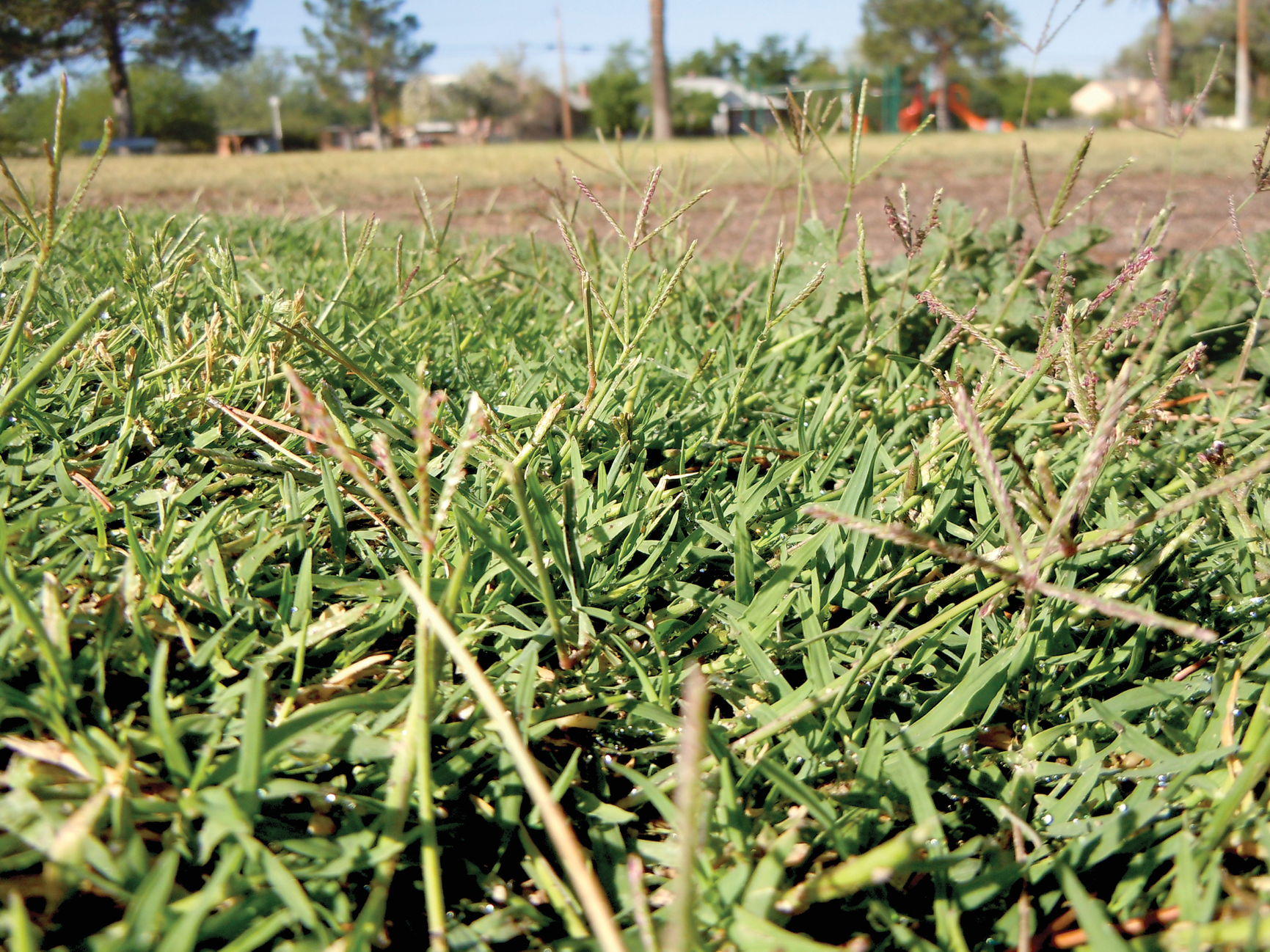

Georgia has been historically dominated by two perennial forage grass production systems: tall fescue in the north and bermudagrass in the south. Climatologists have documented notable changes in temperature and precipitation patterns in the state that have contributed to an invasion of warm-season species in the northern portion of the state. This article documents the expansion of warm-season bermudagrass into northern Georgia, explores the climatic factors driving this transition, and highlights previous and ongoing research. Earn 0.5 CEUs in Crop Management by reading this article and taking the quiz.
In many parts of the temperate world, cool‐season grasses predominate since they are adapted to colder temperatures (59 to 77°F; Barnes et al., 2003). The southern transition zone encompasses the region of North America where cool‐season perennial grasslands transition into fields dominated by more warm‐season grasses. Historically, north Georgia was part of the southern transition zone and was dominated by cool‐season forages such as tall fescue and white clover. Likewise, warm‐season forages such as bermudagrass and bahiagrass cover much of the southern part of the state. These areas are separated approximately at the 33°N parallel by the fall line, a geologic boundary that marks the prehistoric shoreline of the Atlantic Ocean and divides the Piedmont and Coastal Plain regions (Figure 1). The Piedmont will be the main region in our discussion.
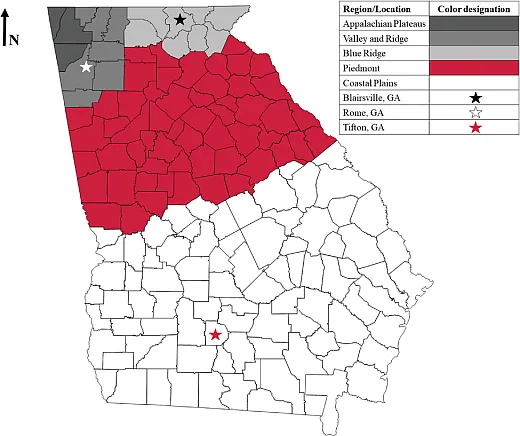
While once dominated by cool‐season forages, the northern parts of the state (especially the Piedmont) are slowly being invaded by warm‐season weeds and forages. There could be several possible explanations for this transition, including poor forage and grazing management. Approximately half of the farms in the region are habitually overstocked. Fall armyworms do not invade the state often, but when they do, the damage is quite severe. Although the state generally receives abundant rainfall, it can have periods of above‐average precipitation, which will leave some grasslands flooded. Alternatively, the state also is prone to periodic droughts. Both extremes are severely damaging to forage grass and will cause stand decline.
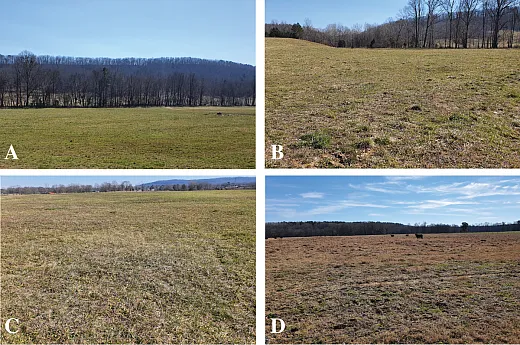
To document the northern spread of warm‐season species in Georgia, 18 University of Georgia county extension agents were interviewed in the fall (November) 2021. It is not surprising that 92% of the responses said less than half of their county could be classified as grasslands. Only 45% of the responses indicated that tall fescue comprised more than 60% of the area with the remaining 55% reporting less than 60% tall fescue in the grasslands of their county. To substantiate this response, agents were asked to complete an assessment of the grasslands in their county and assign a percentage to four color categories: nearly all green, more green than brown, more brown than green, and nearly all brown (Figure 2 and Table 1). Only 39% of the area was reported as nearly all green. Since tall fescue is the dominant cool‐season perennial forage in the region, we assume that “nearly all green” corresponds to tall fescue stands instead of winter annual weeds (i.e., annual ryegrass). On average, 32% of the area was more green than brown. These areas are likely still dominated by tall fescue but are beginning to see invasion of warm‐season weeds such as annual foxtail, crabgrass, or common bermudagrass. Thirty percent of the area was rated as more brown than green and 15% as nearly all brown, indicating an invasion by warm‐season species.
| Color categories | Minimum | Maximum | Average | Standard deviation |
|---|---|---|---|---|
| Nearly all green | 10 | 90 | 39 | 26 |
| More green than brown | 10 | 100 | 32 | 22 |
| More brown than green | 5 | 50 | 30 | 13 |
| Nearly all brown | 5 | 25 | 15 | 8 |
Proposed Solution: Transition Traditional Tall Fescue
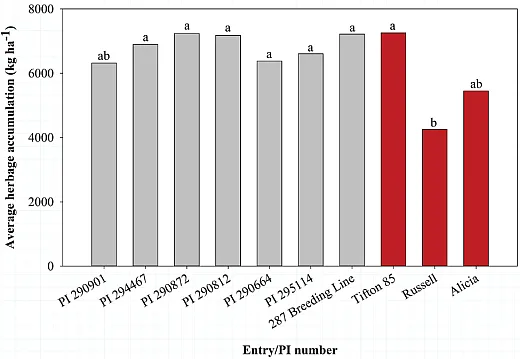
As the climate continues to change, the area in Georgia and the transition zone that will be capable of growing warm‐season forages will continue to expand. Furthermore, as tall fescue stands continue to decline, it will be important to replant these fields with a cold‐hardy, warm‐season forage to help compete with warm‐season weed species.
Three replications of the entire bermudagrass core collection (175 entries) (Anderson, 2005) were planted at the Georgia Mountain Research and Education Center at Blairsville, GA. The long‐term average minimum temperature at this site is 43.0°F, much lower than the average minimum for Tifton, GA (54.9°F) where bermudagrasses have historically been bred (UGA Weather Network, 2022).
Of the 175 entries planted in this trial, 31 did not survive the winter of 2007–2008. During January of 2010, there was period of seven days out of nine (January 3 to 11) where maximum temperatures never went above freezing (UGA Weather Network, 2022) while maximum daytime temperatures for the two winters before were always above freezing. This long period of continuous freeze in January of 2010 resulted in the death of all the 175 entries. Of the 144 entries that survived the first two winters, only 13 accessions had a higher average herbage accumulation than Tifton 44 (the current standard for cold‐tolerant bermudagrass). Of the experimental lines, only PI 290660 had a greater in vitro dry matter digestibility than Tifton 44. Among the most cold‐tolerant lines from Blairsville, PI 225809 and PI 291724 might be used in breeding to improve cold tolerance.
Further research is underway to evaluate herbage accumulation, spring recovery and survival, and bermudagrass stem maggot (BSM, Atherigona reversura) response of 10 hybrid bermudagrasses in northwest Georgia (Gates et al., 2021). The long‐term average minimum temperature at this site is 47.5°F, much cooler than the average minimum for Tifton, GA (54.9°F) where the germplasm was initially evaluated (UGA Weather Network, 2022). For two winters following establishment, severe cold temperatures (< 25.0°F) have been infrequent and brief. Although spring recovery was somewhat slow for some entries, there was no evidence of plant mortality. Visual spring recovery was highest for Alicia, intermediate for Tifton 85 and Russell, and lower for experimental entries. Accumulated forage was lowest for Russell, intermediate for Alicia, and highest for Tifton 85 and all of the experimental hybrids (Figure 3). These new experimental hybrids show promise, but this research should continue to better understand how these varieties will respond the extreme freeze events.
Anticipated Challenges as We Move Forward
Replanting tall fescue fields with bermudagrass appears to be feasible based on early research. However, the transition from a tall fescue‐based production system to a bermudagrass‐based system is more complicated than just replanting. Changing the forage base will require changes in forage and grazing management. One of the biggest changes when switching from tall fescue to bermudagrass will be the shift in dominant forage growth from spring and autumn to summer. Farmers will also need to account for differences in forage nutritive value and herbage accumulation. Tall fescue is generally higher in total digestible nutrients (TDN) than bermudagrass. Conversely, bermudagrass tends to be more productive than tall fescue and generates more herbage mass but to the detriment of herbage availability in cold, winter months.
Farmers will also need to consider the time and expense of renovating a field to plant bermudagrass. Many livestock farms in Georgia are overstocked, and farmers do not have the ability to remove animals from the renovated field for several months to allow for good establishment of the bermudagrass. Another costly change in management will be the routine use of insecticides to control the BSM (Baxter et al., 2019). In addition to fall armyworms, bermudagrass must be treated several times each season with strategic applications of pyrethroid insecticides to suppress populations of the BSM.
Conclusions and Future Work
Documented change in temperature and precipitation patterns in Georgia have contributed to an invasion of warm‐season species in the northern portion of the state. Integrating improved bermudagrass hybrids into the southern transition zone can help producers in this region maintain forage production and compete with noxious weeds that would otherwise appear in declining tall fescue stands. Although necessary, as increasing temperature and risk of severe drought rises, the conversion from a cool‐season forage base to a warm‐season base is both time consuming and expensive. This change will be necessary though, especially as the temperatures and the risk of severe drought continue to increase.
References
Anderson, W.F. (2005). Development of a forage bermudagrass (Cynodon sp.) core collection. Grassland Science, 51, 305–308. https://doi.org/10.1111/j.1744‐697x.2005.00040.x.
Barnes, R.F, Nelson, C.J., Moore K.J., & Collins, M. (2003). Forages, an introduction to grassland agriculture (6th ed. Vol. 2). Blackwell Publishing.
Baxter, L.L., Anderson, W.F., Hudson, W.G., Hancock, D.W., Prevatt, C.G., & Moore, Z. (2019). Quantifying the damage potential of the bermudagrass stem maggot. Crop Science, 59, 2280–2286. https://doi.org/10.2135/cropsci2019.04.0220
Gates, R., Anderson, W.F., Baxter L.L., & Hammond, K. (2021). Hybrid bermudagrass performance and bermudagrass stem maggot tolerance in northwest Georgia. Annual Meeting, Georgia Association of County Agricultural Agents. 16–17 Nov. 2021, Tifton, GA.
UGA Weather Network. (2022). Climate average. University of Georgia Weather Network. http://www.georgiaweather.net/
DIG DEEPER
This article is based on an article published in Grass and Forage Science. See https://doi.org/10.1111/gfs.12568
Self-Study CEU Quiz
Earn 0.5 CEUs in Crop Management by taking the quiz. For your convenience, the quiz is printed below. The CEU can be purchased individually, or you can access as part of your Online Classroom Subscription.
- Cool-season forages grow best at which temperatures?
- 33 to 41°F
- 41 to 59°F
- 59 to 77°F
- 77 to 95°F
- Grazing management impacts forage persistence and longevity of the stand.
- True.
- False.
- The percentage of brown ground cover in November (autumn/winter) in Georgia decreased because of the invasion of warm season grasses or weeds.
- True.
- False.
- Where has forage bermudagrass been historically bred in Georgia?
- Athens.
- Blairsville.
- Calhoun.
- Tifton.
- What is the biggest limitation for plant breeders as they move bermudagrass northward?
- Elevation.
- Soil type.
- Freeze events.
- Slope.
Text © . The authors. CC BY-NC-ND 4.0. Except where otherwise noted, images are subject to copyright. Any reuse without express permission from the copyright owner is prohibited.



